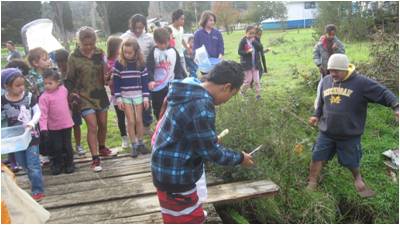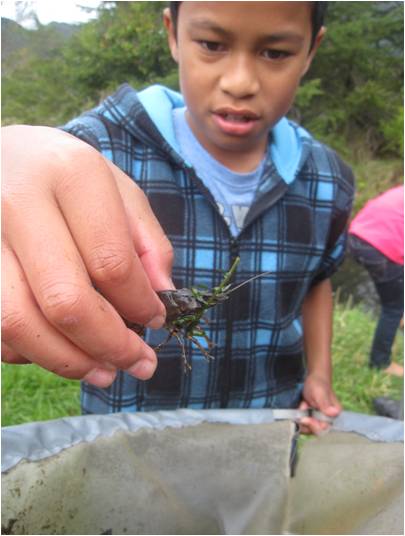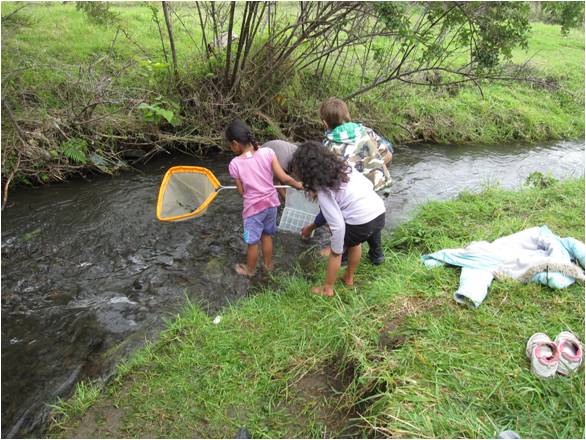 All 49 Waima School students from Year 1-8 took part in the WBC programme in Term Two, 2013 with coordinator Soozee McIntyre thanks to support from the ASB Community Trust and the Department of Conservation.
All 49 Waima School students from Year 1-8 took part in the WBC programme in Term Two, 2013 with coordinator Soozee McIntyre thanks to support from the ASB Community Trust and the Department of Conservation.
Waima School's goal when doing the WBC programme was to compare biodiversity at an upper and lower site in order to gain an understanding of the threats to stream health.
The school charter includes the history and connections of the local people to the maunga and awa (mountains and waterways) of the area and many of the children have some background understanding of the landscape through their knowledge of their whakapapa.
Waima School sits at the base of the Waima Range which is steep and forest-covered. The Kauati Stream, originating in the forest, flows mainly through bush before crossing a narrow band of farmland behind the school then along the front of the school grounds, under the highway and on to where it joins the Waima River which flows into the Hokianga Harbour. Although far from pristine, Waima Forest has good natural biodiversity and the steams emerging from it are clear, with gravelly/stony streambeds. Riparian zones are unprotected below the bushline but grazing is not very intensive in the school vicinity. Downstream of the school is more intensive farming, including dairying, and the Waima River mouth shows signs of sedimentation due to land-use.
 As a relatively clean freshwater ecosystem, the field trip area gave the students an experience of the biodiversity values that can be observed close to the top of the catchment. Aim of the investigation was to gain an understanding of what constitutes a healthy stream and prompt further enquiry into how that stream health can be maintained throughout the catchment which ultimately reaches the Hokianga Harbour.
As a relatively clean freshwater ecosystem, the field trip area gave the students an experience of the biodiversity values that can be observed close to the top of the catchment. Aim of the investigation was to gain an understanding of what constitutes a healthy stream and prompt further enquiry into how that stream health can be maintained throughout the catchment which ultimately reaches the Hokianga Harbour.
 The children were delighted to find tuna (eels) and koura (crayfish) in the stream they visited and had most informative discussions with their caretaker's partner, Pia, and another local elder who told them about how much more abundant those species were in their younger days!
The children were delighted to find tuna (eels) and koura (crayfish) in the stream they visited and had most informative discussions with their caretaker's partner, Pia, and another local elder who told them about how much more abundant those species were in their younger days!
Click here for a full record of their field trip including awesome pictures and their findings.
 Students and teachers gained understanding of the connections of the tuna to the marine environment and the importance of access to the freshwater environment for a major part of their life cycle. This was reinforced by reading (with hand puppet show!) of the eel story ‘Velvet and Elvis’, which prompted lively discussion about where the elvers they found might be heading and what they might find to eat in the Kauati Stream. The lack of whitebait species was also discussed (apparently there is still some whitebait caught near the Waima river-mouth) and the possibility of finding some in the more shaded area of the stream at the bush-line.
Students and teachers gained understanding of the connections of the tuna to the marine environment and the importance of access to the freshwater environment for a major part of their life cycle. This was reinforced by reading (with hand puppet show!) of the eel story ‘Velvet and Elvis’, which prompted lively discussion about where the elvers they found might be heading and what they might find to eat in the Kauati Stream. The lack of whitebait species was also discussed (apparently there is still some whitebait caught near the Waima river-mouth) and the possibility of finding some in the more shaded area of the stream at the bush-line.
Plans are underway to source native plants for riparian planting at the (streamside) front of the school – with help from Todd at DoC. Pia is keen to help with siting and protecting the plants.

The teachers plan to follow-up with a further field trip (when the weather is warmer) to a comparison site nearer the forest and to establish a regular schedule of monitoring to observe seasonal differences in abundance and diversity of freshwater life.

Teachers observed that all the children were fully engaged during the class sessions and, especially, during the field trip, with some of the reluctant learners taking an active part in discussions for the first time ever! Pia was very pleased to get experience with the stream gear as he will play an active role in any continuing monitoring. DoC Liaison Officer, Todd, attended all the classroom sessions and the field trip and remarked on how effective the programme is in its approach. Todd’s background is in primary teaching and he was impressed with the active learning and enthusiasm of the children.
